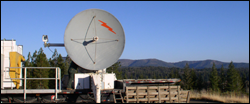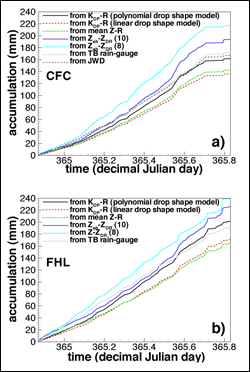HMT Publication Notice
A journal article, Evaluating Polarimetric X-band radar rainfall estimators during HMT, by Sergey Y. Matrosov appeared in the January 2010 issues of Journal of Atmospheric and Oceanic Technology, 27, 122-134, doi:10.1175/2009JTECHA1318.1.
Improving accuracy of quantitative precipitation estimation (QPE) from radar measurements is an important objective for meteorological and hydrological studies. One way of improving radar QPE is to introduce more information in radar measurements using a concept called polarization diversity. The use of "gap filling" radars in areas where coverage from NOAA's operational NEXRAD (WSR-88D) radars is not adequate is another way to get better radar QPE. Combining these approaches holds significant promise and has been a thrust of HMT-West field efforts. X-band radars are well suited for gap filling purposes in mountainous areas because they are transportable, relatively small and use less power than NEXRAD radars. Decreases in signal strength caused by moderate and heavy precipitation (a limitation of X-band radars) can be corrected through specialized polarimetric techniques. These correction methods take advantage of polarimetric differential phase measurements. Differential phase and differential reflectivity radar data (in addition to conventional reflectivity) also allow for constructing more accurate rainfall estimators. This study describes the assessment of different polarimetric and reflectivity based X-band radar QPE approaches during the deployment of the NOAA/ESRL/PSD HYDROX radar in the Foothills of Sierra Nevada during the 2005-2006 winter season. The results provide guidance for generating state-of-the art precipitation data sets for use in evaluating meteorological and hydrological models.


 Read the Abstract
Read the Abstract